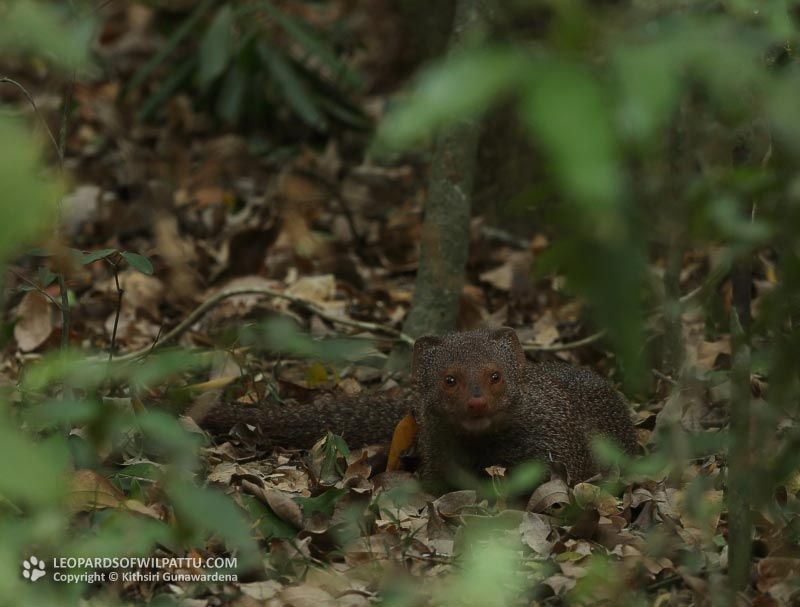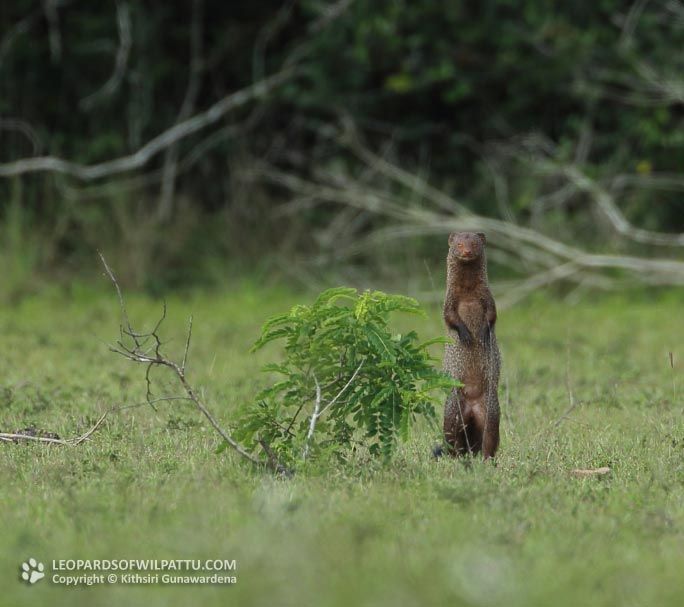
Mammals ‹‹ Go Back
Two subspecies have been recognized of this versatile species and they are found only in India and Sri Lanka. The subspecies H.s. zeylanius is endemic to Sri Lanka while H. s. smithii is endemic to India. The conservation status of this species is regarded as Least Concerned (National Red list 2012) and it is a species protected under the Fauna and Flora Protection Ordinance as amended by Act No. 22 of 2009.
I have always observed the Ruddy Mongoose in forests or well-wooded gardens adjacent to forests. It is seldom found in open areas or plains. This is a diurnal species and appears to subsist mainly on a carnivorous diet. The highest altitude at which I have recorded this species is at Manigala in the Knuckles forest reserve at 1200 meters. It is very common in the southern dry zone National Parks such as Yala, Kumana, Bundala, Lunugamvehera and Udawalawa. In the wet zone I have seen it at Sinharaja forest reserve, Labugama, Bodinagala, Batadomba Lena in Kuruwita, Meethirigala, Haldummulla and at Beragala at an attitude of 820 meters. I have also seen this species at Galoya, Maduruoya, Wasgomuwa, Randenigala and Minneriya-Giritale National Parks. It is also common in Sigiriya, Dambulla, Koslanda, Wellawaya and in Nilgala. Despite many visits I have never seen it in the Mannar Island.
In Wilpattu this is a species that I have recorded during each of my field visits. They are generally seen in tall forest areas such as the road between Nelum Wila and Panikkar Villu and between Borupan Wila junction and Kumbuk Wila. At Borupan Wila once I observed a Ruddy Mongoose arrive under a Wild Boar kill’ that was tree by a Leopard and run in to the forest with a scrap that it found on the ground.
On the 13th October 2013 I was able observe an interesting encounter between a Ruddy Mongoose and a Leopard. Around 3.25pm I was observing a leopard that was sleeping on the bund across the road at Walas Wala. A Ruddy Mongoose walked out of the forest from the right hand corner of the bund but was not able to see the sleeping Leopard in the opposite corner. It continued to walk in the direction of the sleeping Leopard. I kept on photographing the Mongoose expecting the Leopard to wake up and attack at any moment. Even though the sleeping Leopard could be seen from the vehicles parked on the bund, the Mongoose was not able to see the predator as the bushes growing on the bund covered its view. The inquisitive mammal casually trotted pass the bushes along the bund and arrived a few feet in front of the sleeping Leopard where it suddenly became aware of the predator. Upon seeing the Leopard it froze for a moment with its tail hairs puffed up, turned back in one swift action and bolted at great speed in to the jungle. Fortunately for the mongoose the Leopard slept through the whole episode. This experience reminded me of a paragraph written by W.W.A. Phillips describing the extreme fear Ruddy Mongoose has towards Leopards, on page 190 in his Manual of the Mammals of Ceylon (1935) which I will reproduce below for the benefit of the reader.
For the leopard, this mongoose appear to have a wholesome respect. Two watched at a leopars kill were obviously very nervous and eventually fled, chattering with fright, on the approach of the leopard. Near another kill’, one was found dead, having evidently been caught and killed by the leopard.








